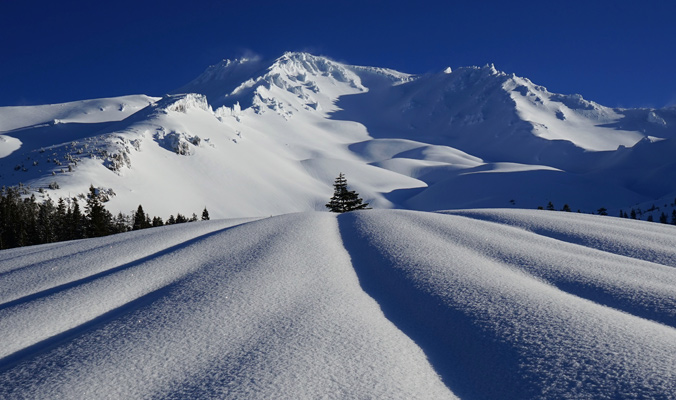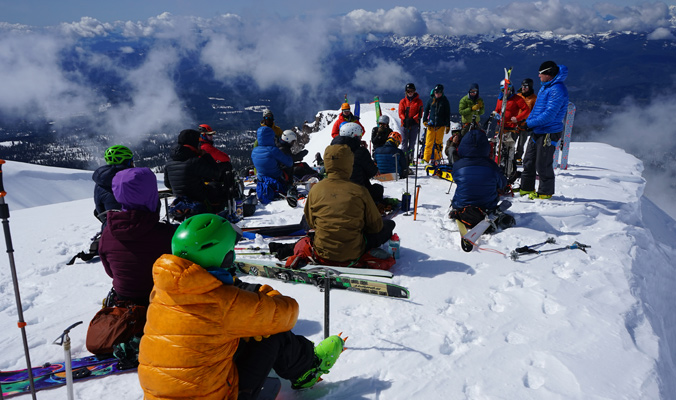
View of Mt. Shasta from Avalanche Gulch. [Photo] Chris Carr
“Shasta is a unique peak that has helped play a role in carving out a career path for many guides,” Carr says. He and his wife Jenn took over the company in 2003 after years of guiding on the mountain. “I still remember the first time I saw the peak,” Carr says. “I got goose bumps, and, even today, I’ll return to it and continue to be just as awe-inspired by its beauty and presence.”
Originally from Massachusetts, Carr grew up skiing on the East Coast, perusing ski magazines and idolizing the sport. It was in those magazines that he first saw images of the Shasta Ski Bowl—the resort on Shasta’s southern flank, which founded in 1959, destroyed by a massive avalanche in 1978 and re-opened in 1985 at a new location down mountain dubbed Mt. Shasta Ski Park.
But Carr was always drawn to Shasta’s more remote aspects. “I moved here after college and started climbing and ski mountaineering,” he says. “I remember my first trip up [Shasta] was in November—not a good time to climb— and I almost died because of the consistent falling debris.”
After two years of climbing and becoming acquainted with the mountain’s rangers, one of them suggested he get in touch with Michael Zanger, owner and operator of Shasta Mountain Guides at the time. “Essentially, I just cold-called him and sent him a letter of interest,” Carr explains. “The next thing I knew, I was a part of the team.”

SMG guide training in the Pacific Northwest sun. [Photo] Chris Carr
“It was definitely a huge learning curve in going from guiding to business owners,” Carr remembers. “[There’s] endless work behind the scenes that you don’t think about when you take over.”
In spite of the hard work, the Carrs were able to develop a network of guides and support that helped set the precedent for the small community and the guide scene in Shasta, an area that sees upward of 10,000 climbers each year.
“The company has provided economic stimulation, which is important in a community that’s based around recreation,” says Jenna Kane, who guides for SMG and grew up in town. “They provide a lot of jobs for the youth and have become a focal point for leadership as well as for backcountry skiing and climbing culture in our community.”
This network has extended itself far beyond the town and has grown into a meeting point of mentorship and community for guides new to the world of mountaineering. “For a brand new guide to be able to work with experienced guides is an asset you find in very few places,” Carr explains. “On a busy weekend, we can have 15 to 16 guides on the mountain ready to help support and back each other up. This helps create aspects and opportunities for learning and mentorship.”
While SMG typically has around 30 guides working each season, over the years the company has served as a stepping stone for many guides who have gone on to achieve Everest ascents, positions of lead, head and senior guide roles around the world, directors of avalanche centers, heli operations and many other roles that have influenced the mountaineering and ski community.
Eric Layton is one such guide. He began working on Shasta in 2007 and, in 2015, became the first guide to complete the AMGA Ski Guide certification on a splitboard. Aside from his various roles with many operations—as well as his own Splitboard Guides International—he consistently returns to Shasta season after season.
“It’s typically perfect weather, snow and mixed terrain that lends itself to so many opportunities,” Layton says. “Even after guiding internationally, it always comes back to Shasta, because the skiing is just that good.”
For the Carrs, it is all about the network they have helped create for SMG, oftentimes by relying on word-of-mouth marketing within the outdoor community. “The mountain itself is so inspiring and spiritual, but it really is the people and the community that make it that way,” Carr says. “To see guides come back year after year is as priceless and special as this place that we call home.”











Related posts: